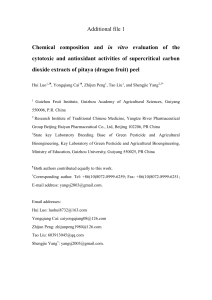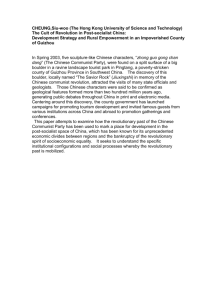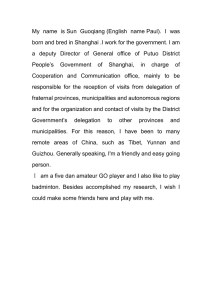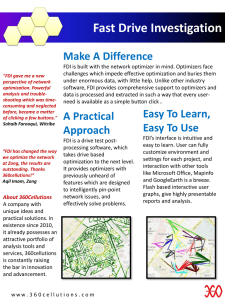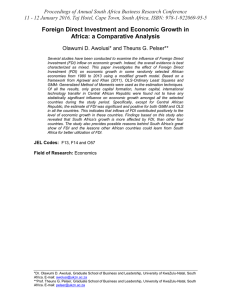Document 13725742
advertisement
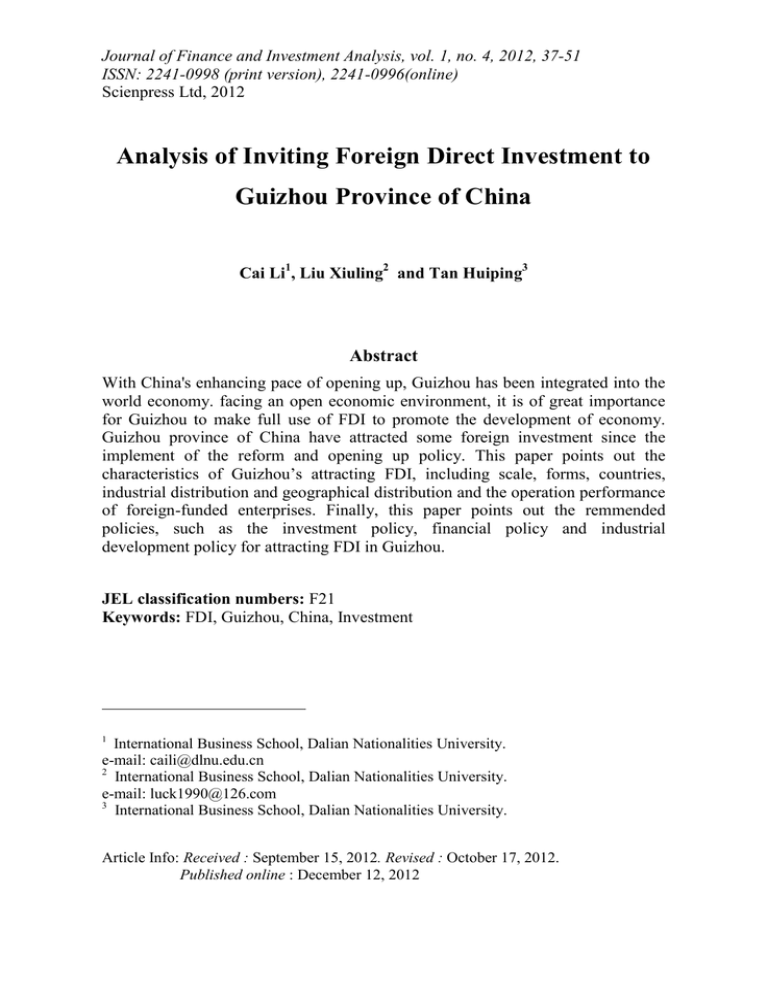
Journal of Finance and Investment Analysis, vol. 1, no. 4, 2012, 37-51 ISSN: 2241-0998 (print version), 2241-0996(online) Scienpress Ltd, 2012 Analysis of Inviting Foreign Direct Investment to Guizhou Province of China Cai Li1, Liu Xiuling2 and Tan Huiping3 Abstract With China's enhancing pace of opening up, Guizhou has been integrated into the world economy. facing an open economic environment, it is of great importance for Guizhou to make full use of FDI to promote the development of economy. Guizhou province of China have attracted some foreign investment since the implement of the reform and opening up policy. This paper points out the characteristics of Guizhou’s attracting FDI, including scale, forms, countries, industrial distribution and geographical distribution and the operation performance of foreign-funded enterprises. Finally, this paper points out the remmended policies, such as the investment policy, financial policy and industrial development policy for attracting FDI in Guizhou. JEL classification numbers: F21 Keywords: FDI, Guizhou, China, Investment 1 International Business School, Dalian Nationalities University. e-mail: caili@dlnu.edu.cn 2 International Business School, Dalian Nationalities University. e-mail: luck1990@126.com 3 International Business School, Dalian Nationalities University. Article Info: Received : September 15, 2012. Revised : October 17, 2012. Published online : December 12, 2012 38 Cai Li et al. 1 Introduction In the wake of the internationalization, Guizhou Province has interacted with the global economy gradually. To further promote the economic development in Guizhou, State Council of the People’s Republic of China highlighted in Opinions of State Council on Further Promoting Sound and Rapid Economic Development of Guizhou Province (2012), "Guizhou should make full use of the opportunities of China - ASEAN Free Trade Area, Greater Mekong Subregion, Pan-Pearl River Delta and other platforms to actively cooperate with south Asia and other neighbouring regions, so as to be increasingly open." FDI is an important external force for Guizhou to boost the economic development. At the same time, foreign-funded enterprises creat a large number of job opportunities, prompt the upgrading of the industrial structure in Guizhou, and in particular deepen the intrinsic link between Guizhou and other regions and countries. Foreign-funded enterprises have become a significant driving force of the economic development of Guizhou, and play an indispensable role in impelling the sustainable social development in Guizhou. This paper analyzes the impact of FDI in Guizhou and gives the suggested policies for Guizhou government and foreign-funed enterprises for further development as well. 2 The situation of utilization of FDI in Guizhou province 2.1 The amount of utilization of FDI With the development of the expanded FDI, the performance of foreign investment has been improved. Japan's Kyocera Corporation established a joint venture-Kyocera Zhenhua Communication Equipment Co., Ltd. in Guiyang to produce CDMA mobile phones and related communication products, with the total investment of USD37.22 million. Zhuli Electric (Guiyang) Co., Ltd. invested by Hong Kong Zhuli Electric Company is a large-scale foreign-funded export processing enterprise. Its investment rises from the initial HKD1.8 million to HKD45 million. SunStar from Korea and Hong Kong Rui Xing Company invested USD2 million in the establishment of Guiyang Xiang Yun Fine Chemical Co., Ltd. jointly. Dragon Smarter Investment Limited invested USD 13 million in Qianchun Road Reconstruction Project. On the other hand, the structure of the industries invested by foreign investors has been further optimized. High-tech, export-oriented enterprises in Guizhou and deep processing projects absorb more foreign investment. In recent years, the large-scale projects of Snecma, Hong Kong New World Group, USA Wal-Mart and Malaysia Parkson Group have been completed and put into operation successfully. High-tech, high value-added industries and business services have become the hot spots of FDI in the recent years. In Guizhou, more and more FDI Analysis of Inviting Foreign Direct Investment 39 projects are involved with the foreign investment beyond USD10 million, particularly Hong Kong New World Group invested USD244.9 million in real estate sector in Jinyang New District of Guiyang City. In recent years, the scale of FDI in Guizhou tends to become much larger. From 2005 to 2010, FDI in Guizhou showed that Guizhou's foreign investment utilization was featured with three stages: first, from 1985 to 1992, the scale of FDI was relatively small and grew slowly; second, from 1993 to 2004, the FDI scale was slightly bigger than that of the first stage, and the value fluctuated up and down at USD40 million; third, from 2005 till now, the FDI has surpassed the threshold of USD100 million and tended to rise at a high growth rate. Especially in 2011, the actually utilized foreign investment amounted to USD670 million, both of the contractual foreign investment and the actually utilized foreign investment set new records in Guizhou. Table 1: The amount of utilization of FDI in Guizhou, 1979-2011 (USD10,000) Year Actually Used FDI Year-on-year Growth Rate (%) 1979-1983 1984 1985 1986 1987 1988 1989 1990 1991 1992 1993 1994 1995 1996 1997 1998 1999 2000 2001 2002 2003 2004 2005 2006 2007 2008 148 74 101 440 747 468 734 1979 4294 6363 5703 3138 4977 4535 4090 2501 2829 3700 5626 6533 10768 9384 12651 14904 -50 36.49 335.64 69.77 -37.35 56.84 169.62 116.98 48.18 -10.37 -44.98 58.6 -8.88 -9.81 -38.85 13.11 30.79 52.05 16.12 64.82 -12.85 34.81 17.81 Foreign Captial Actually Absorbed 286 1276 376 1408 2102 2983 2845 3574 4922 8363 9637 10628 13834 18100 19532 19545 14010 9383 13191 13932 19568 18413 15333 17379 Proportion of Used FDI in Foreign Captial Absorbed (%) 51.75 5.8 26.86 31.25 35.54 15.69 25.8 55.37 87.24 76.09 59.18 29.53 35.98 25.06 20.94 12.8 20.19 39.43 42.65 46.89 55.03 50.96 82.51 85.76 Cai Li et al. 40 2009 2010 2011 13364 29546 67000 -10.33 121.1 127.9 18027 45024 171000 74.13 65.62 39.18 "-" stands for data not available. Source: Guizhou Provincial Bureau of Statistics, China National Bureau of Statistics Survey Office in Guizhou, Guizhou Statistical Yearbook (Beijing,2011) 2.2 The performance of utilization of FDI Compared to the China national average level, FDI in Guizhou develops slowly with a small scale, as the performance index of utilization of FDI of Guizhou (INDi) shows. INDi = (FDIi / FDIw) / (GDPi / GDPw) FDIi refers actually used amount of FDI of this region (i), FDIw refers actually used amount of FDI of the whole country. GDPi refers the gross domestic product of this region (i), GDPw refers the gross domestic product of the whole country. Generally, the bigger the economic scale of a region is, the more FDI it attracts. If INDi is equal to 1, the proportion of this region’s FDI in the country’s FDI is the same with the proportion of its GDP in the country's GDP, reaching the national average level of this country. If INDi is greater than 1, the region absorbs more FDI relative to its GDP, higher than the national average level. If INDi is less than 1, FDI is lower than the national average level maybe due to the weak economic competitiveness of this region. According to the method above, Guizhou's INDi in 1990, 1995, 2000-2011, was calculated, just shown in Table 2. According to Table 2, Guizhou's INDi was always lower than 1, and generally less than 0.2. Only in 2010 and 2011, it was higher than 0.2. This indicates that Guizhou’s INDi is lower than the China national average level, and often less than 20% of the China national average level. The average INDi within 14 years of Guizhou is only 0.144, equivalent to one seventh of the China national average level. This reveals that Guizhou has not yet become an attractive FDI hot spot compared with other regions of China, which is not consistent with China's western development strategy and the trend of FDI in China with is transferring to the western regions of China. Table 2: The performance index of utilization of FDI in Guizhou, 2000-2011 (USD100 mln) Analysis of Inviting Foreign Direct Investment 1990 1995 2000 2001 2002 2003 2004 2005 2006 2007 2008 2009 2010 2011 Amount of Actually Used FDI in Guizhou Amount of Actually Used FDI in China 0.05 0.57 0.25 0.28 0.37 0.56 0.65 1.08 0.94 1.27 1.49 1.34 2.95 6.7 34.9 375.2 407.2 468.8 527.4 535.1 606.3 603.3 630.2 747.7 924 900.3 1057.4 1160.1 41 Proportion of Guizhou's FDI Used in China’s FDI Used (%) 0.13 0.15 0.06 0.06 0.07 0.11 0.11 0.18 0.15 0.17 0.16 0.15 0.28 0.57 Proportion of Guizhou's GDP in China’s GDP (%) 1.39 1.05 1.04 1.03 1.03 1.05 1.05 1.07 1.05 1.03 1.06 1.14 1.15 1.18 Guizhou's INDi 0.01 0.15 0.06 0.06 0.07 0.1 0.1 0.17 0.14 0.16 0.15 0.13 0.24 0.48 Source: Guizhou Provincial Bureau of Statistics, China National Bureau of Statistics Survey Office in Guizhou, Guizhou Statistical Yearbook (Beijing,2011) 2.3 Utilization of FDI by country or region The overseas investors from 30 countries and regions are mainly from Asian countries and Hong Kong. Especially, Hong Kong enterprises invest in Guizhou's manufacturing, real estate, electric power, mining, agriculture, services and other sectors. The main sources of the FDI in Guizhou lies in Asia, with about 43% share, following by America. By country (region), the FDI clearly depends on only a few regions and countries including Hong Kong and the British Virgin Islands. Since the reform and opening up policy of China was implemented, by the end of 2010, more than 600 Hong Kong enterprises have invested in Guizhou. Among the foreign investment institutions in Guizhou, enterprises from Hong Kong accounted with a high proportion. In Guizhou, Hong Kong investors had 681 investment projects, with the cumulative contracted foreign investment of USD2.481 billion and the cumulative actually used foreign capital of USD865 million. In 2010, the actually used foreign investment from Hong Kong was USD180 million, 10 times of that in 2006. The FDI projects were involved with farming, forestry, animal husbandry, fishery, manufacturing, transport, warehousing, postal services and other sectors. From January to October of 2011, Asian countries (regions) invested 35 FDI projects in Guizhou, accounting for 67.3% of the total number of the FDI projects in Guizhou in that year. The actual investment valued USD347.5 million, Cai Li et al. 42 accounting for 82.8% of actually used FDI in Guizhou in 2011. Particularly, Hong Kong invested 28 projects in Guizhou, accounting for 53.8% of the total number of the FDI projects in that year; the actual investment reached USD333.29 million, accounting for 79.3% of FDI in Guizhou in 2011. Guizhou’s FDI depends on only a few regions and countries obviously. Once their economic situation and trade policies change dramatically, their investment in Guizhou may be substantially reduced, therefore Guizhou should not only maintain the current relationship with these countries and regions, but also actively establish the good relations with developed countries in Europe and America as well as introduce the investment from these developed countries vigorously to improve the status quo and avoid vulnerabilities and risks incurred by the current simple structure of FDI countries and regions. Table 3: Cumulative utilization of FDI in Guizhou by country or region (Top 10), 2004-2009 (USD10,000) Cumulative Actually Used FDI Amount Share(%) 23837 35.26 No. Country / Region 1 Hong Kong 2 British Virgin Islands 21429 31.69 3 Mauritius 4930 7.29 4 Australia 4018 5.94 5 Singapore 3574 5.29 6 Canada 2170 3.21 7 USA 2109 3.12 8 France 1569 2.32 9 Cayman Islands 765 1.13 10 Samoa 648 Source: Guizhou Provincial Department of Commerce 0.96 2.4 Utilization of FDI by industry Through Table 4, for a long time, a very small amount (4.53%) of FDI was used in the primary industry of Guizhou. More than 64% of the FDI projects for contracted FDI and capital concentrated in the secondary industry. About 30% of the FDI projects and capital lied in the tertiary industry. Only in 2005, 2006 and 2010, more FDI was used in the primary industry. Little investment was invested in the primary industry in 2008 and 2009. In other words, a small amount of FDI was used in agriculture industry. According to the historical data, since 1986, FDI has focused on the secondary industry, mainly manufacturing sector. Compared with the primary industry and Analysis of Inviting Foreign Direct Investment 43 the tertiary industry, the secondary industry of Guizhou attracts more FDI. From January to August of 2011, the actually used FDI in the secondary industry reached USD224.03 million, accounting for 63.1% of the total foreign capital used in Guizhou; wherein, the manufacturing sector introduced USD148.30 million, accounting for 41.8% of the total FDI used in Guizhou. In the terms of the cumulative amount of FDI, only 30% of the foreign capital was invested in the tertiary industry. However, in recent years, with the development of Guizhou's tertiary industry, foreign investment projects have gradually concentrated in the tertiary industry. In 2007, the amount of FDI in the tertiary industry was almost the same with that in the secondary industry. In the tertiary industry, real estate, scientific research, technic services and geological prospecting, and financial intermediation sectors are the central parts of FDI targets. In these sectors, the capital flows fast, and high profits are generated easily. On the contrary, social services, science, education, culture and health care sectors attract less FDI. On the whole, the amount of FDI in the tertiary industry is far smaller than that of the secondary industry. In 2011, the targets of FDI changed significantly. Electric power, gas and water production and supply sectors became the new highlights. In the first half year of 2011, the actually used FDI (86% of the total amount of FDI in Guizhou) was mainly applied to “electric power, gas and water production and supply” (USD70 million), “farming, forestry, animal husbandry and fishery” (USD60 million), “leasing and business services” (USD30 million), “transport, storage and post” (USD30 million). While, in the same period of 2010, 92.5% of the actually used FDI was mainly used in manufacturing and real estate sectors. Table 4: Cumulative utilization of FDI in Guizhou by industry, 1986-2010 (USD10,000) Projects for Contracted FDI Number Share (%) 82 4.3 Actually Used FDI Amount Share (%) 7363 4.53 Primary Industry Secondary 1229 64.58 106279 65.45 Industry Tertiary 592 31.1 48728 30.01 Industry Total 1903 100 162370 100 Source: Guizhou Provincial Bureau of Statistics, China National Bureau of Statistics Survey Office in Guizhou, Guizhou Statistical Yearbook (Beijing,2011) The industrial distribution of the FDI is linked with Guizhou’s regional characteristics, economic development and environments closely. Firstly, foreign enterprises invest little in the primary industry because Guizhou’s agricultural production has not reached the economic scale. On one hand, Guizhou 44 Cai Li et al. has uneven terrain, therefore it is difficult to conduct large-scale farming operation, which does not comply with the requirements of the agricultural machinery. On the other hand, rural areas of Guizhou adopt the Chinese characteristic agricultural management system based on the household contract responsibilities, and the decentralized management of farmers is not favorable to the formation of the economic scale, inconsistent with the requirements of the large foreign enterprises. Secondly, a high proportion of the FDI in Guizhou is used in the secondary industry also because of Guizhou's specific characteristics. Guizhou has rich electric power resources, Chinese herbal medicine resources, mineral resources and agricultural resources, which have become the priorities for foreign investors in Guizhou. Many companies come to Guizhou just for Guizhou's abundant natural resources and mineral resources. For instance, Hong Kong Shui On Group which is engaged in production and development of cement and construction materials aggregated the dispersed local small cement manufacturing companies based on Guizhou's abundant resources. Hong Kong Ease Way Holdings Limited established Kaichen Aluminum Co., Ltd. in Guizhou. These companies are just attracted by the resources of Guizhou, therefore they mainly invest in the secondary industry. In the future, Guizhou should make full use of its advantages in resources to guide foreign capital to invest in the primary industry and the tertiary industry. Meanwhile, it should vigorously introduce the FDI projects with high technology, low energy consumption, environmentally friendly and high added value instead of the projects with high pollution, high energy consumption. In the early stage, a small amount of the FDI was involved with the tertiary industry, maybe due to the former stringent restrictions on insurance, commerce, foreign trade, financial intermediation sectors of Guizhou. Guizhou has been more open and gradually relaxes the restrictions on the above sectors. Guizhou's tertiary industry has also reached a certain scale and more foreign-funded projects will concentrate in the tertiary industry gradually in the near future. 2.5 Operating performance of foreign-funded enterprises According to Table 5, there were 102 foreign-invested designated size industrial enterprises in Guizhou in 2010 with 26,116 employees averagely, the industrial added value of RMB4.044 billion, the total industrial output value of RMB15.75 billion, the industrial sales output value of RMB14.42 billion, the total assets of RMB25.1 billion, the revenue of principle business of RMB14.02 billion, the total profits and taxes of RMB1.82 billion, and the total profits of RMB1.22 billion. The nine indicators accounted for 3.4%, 3.25%, 3.3%, 3.7%, 3.6%, 4.2%, 3.5%, 2.7% and 3.8% separately of all designated size industrial enterprises in Guizhou. The proportions indicates that foreign-invested designated size industrial enterprises in Guizhou have not contribute much to Guizhou's industrial economy yet, without strong driving effects. Analysis of Inviting Foreign Direct Investment 45 Table 5: Major economic indicators of foreign-funded designated size industrial enterprises in Guizhou, 2010 (RMB 100 million) Item Foreign-invested Designated Size Industrial Enterprises All Designated Size Industrial Enterprises in Guizhou Percent of (%) Number of 102 2963 3.4 Enterprises (Unit) Annual Average of All Employees 26116 803000 3.25 (Persons) Value Added of 40.44 1227.17 3.3 Industry Total Output 157.5524 4206.37 3.7 Value of Industry Industrial Sales 144.2 4014.54 3.6 Output Value Total Assets 251.0145 5960.13 4.2 Revenue from 140.2881 3926.01 3.5 Principal Business Total Profits and 18.2221 671.39 2.7 Taxes Total Profits 12.2261 317.63 3.8 Source: Guizhou Provincial Bureau of Statistics, China National Bureau of Statistics Survey Office in Guizhou, Guizhou Statistical Yearbook (Beijing,2011) Table 6 and table 7 show that Guizhou's export value was USD1919.03 million, the import value was USD1218.98 million and the favorable balance reached USD700.05 million in 2010. Wherein, Guizhou's foreign-funded enterprises had the export revenue of USD105.28 million (accounting for 5.48% of Guizhou exports) and paid USD69.2 million (accounting for 5.67% of Guizhou imports) for imports, and the trade surplus reached USD36.08 million. Compared to the China national level, the export contribution of Guizhou's foreign-funded enterprises was 49 percentage points lower than 54.64%-China national average level. As for the import value, their proportion was lower than the China national level by 48 percentage points. It can be seen from the above data that FDI enterprises optimized Guizhou’s export structure to a certain extent, however Guizhou’s overall export scale was small and FDI enterprises in Guizhou did not boost the optimization of the local exports obviously. Table 6: Exports and imports of foreign - funded enterprises of China, 2010 (USD 10000) Cai Li et al. 46 Foreign-funded Enterprises Value of Exports Percent of China Exports (%) Value of Imports Percent of China Imports (%) Equity Joint 23758160 15.05 20978710 15.02 Venture Contractual 1647020 1.04 2385128 1.7 Joint Venture Wholly Foreign-owned 60817702 38.54 52121824 37.33 Enterprises Total 86222882 54.64 75485662 54.06 Source: Department of Trade and External Economic Relations Statistics, China National Bureau of Statistics, China Trade and External Economic Statistical Yearbook (Beijing,2011) Table 7: Exports and imports of foreign - funded enterprises of Guizhou, 2010 (USD 10000) Foreign-funded Enterprises Value of Exports Percent of Guizhou Exports(%) Value of Imports Percent of Guizhou Imports(%) Equity Joint 4204 2.19 4828 3.96 Venture Contractual 266 0.13 186 0.15 Joint Venture Wholly Foreign-owned 6058 3.15 1906 1.56 Enterprises Total 10528 5.48 6920 5.67 Source: Department of Trade and External Economic Relations Statistics, China National Bureau of Statistics, China Trade and External Economic Statistical Yearbook (Beijing,2011) 3 Recommended policy for improving the utilization of FDI in Guizhou 3.1 Investment policy 3.1.1 Setting up investment attraction platform When making full use of famous international and domestic exhibitions to invite FDI, Guizhou government and local enterprises can elaborately plan the investment attraction platforms, specially for the investors from Hong Kong, Analysis of Inviting Foreign Direct Investment 47 Macao, Taiwan and Southeast Asia. They can take full advantage of Guiyang Jinyang International Exhibition Center to build well-known provincial or even national exhibition brand and continue to support “Colorful Guizhou”, Tourism Commodity Design Contest, Craftsmen Contest, Tourism Trade Fair, Alcoholic Beverage Expo, Provincial Tourism Development Forum, Huangguoshu Waterfall Festival and Investment & Trade Fair as well as Guizhou Business Forum, creating more opportunities for domestic and foreign investors to visit and further invest in Guizhou. Each city (county) should build influential investment attraction platforms. 3.1.2 Strengthening construction of FDI project databases In accordance with Guizhou’s “Twelfth Five-Year” Industrial Development Plan, industrialization and urbanization strategies, Guizhou government and local enterprises can make preparation, selection and evaluation of industrial FDI projects with long industrial chain scientifically and reserve management for FDI projects conscientiously, and also review the construction of FDI projects strictly. Complying with the international universal standards, they can work out the technical assessment and cooperation modes for all the recorded FDI projects. For key large projects, the operation study reports about construction plan, environmental protection work and land use should be prepared in order to enhance the quality of the FDI project preparation work. At the same time, banks, industrial parks database, intermediaries and investment attraction networks are required to be combined for local government better services and dynamic management as well. 3.1.3 Attracting investment innovation Guizhou government and local enterprises can explore efficient investment attraction ways with property rights, set up investment attraction platforms outside the province to establish external relations and promote the agent system, encourage various chambers of commerce, provincial (urban, district) chambers of commerce and other related associations to invite foreign investment jointly as an alliance. The enterprises in Guizhou can adopt a variety of effective financing means, including joint ventures, merger and reorganization, equity acquisition, BOT (building - operation - transfer) and TOT (transfer - operation- transfer), BT (building - transfer), ABS (asset securitization) to invite more foreign capital, such as industrial capital, commercial capital and financial capital. They can further raise the level of foreign capital utilization, absorb foreign capital, technologies, talents and management modes rationally and effectively. Also, Guizhou government is required to coordinate the relationship between quantity and quality of foreign investment, combine foreign investment with the adjustment of the industrial structure, the extension of the industrial chain, the 48 Cai Li et al. consolidation of supporting capacities and high-tech industries to promote the industrial structure optimization and upgrading of Guizhou. 3.1.4 Deepening the reform of administrative approval system The relevant departments of Guizhou government should further decentralize the rights in approval and registration of all kinds of FDI projects in investment scale, environmental assessment, construction sites and other aspects. Each city (county) should also do so, as well as stimulate the initiative and creativity of all levels of Guizhou government in utilization of foreign capital expansion and opening up. 3.2 Financial policy Guizhou government should expand the scope that agricultural insurance premium subsidies cover, encourage domestic and foreign financial institutions to initiate new rural financial institutions, advocate insurance funds to flow to transportation, energy, water conservancy, municipal utilities, power grids and other infrastructure and key industrial projects. Also it can strengthen the communication and coordination between local governments and financial regulatory authorities, encourage the cooperation among financial institutions, support the establishment of venture investment guidance fund, standardize the development of equity investment and further promote the marketization of municipal utilities and diversify investment entities. Various financial institutions can innovate financial products to support the construction of industrial development zones in Guizhou, particularly intensify the financial support for FDI projects in Guizhou. Professional insurance institutions can expand the credit insurance coverage, augment the insurance scale, develop the insurance products which support agricultural programs and open economy development in investment attraction, and provide multi-channel insurance services for domestic and foreign cooperation projects in Guizhou. 3.3 Industrial policy Within the scope permitted by China national industrial policy, the restrictions on the access to some industries where Guizhou has resource advantages and huge market demand should be relaxed appropriately. Energy and resources development and utilization FDI projects which can be set up in Guizhou should be planned, designed, examined and approved as priorities. Guizhou's energy-saving and emission reduction targets need be determined reasonably. The central budget of China government is required to help Guizhou closing down the local backward production capacity enterprises gradually. Analysis of Inviting Foreign Direct Investment 49 Guizhou government and local enterprises need support the pilot reform of coal mining rights, guide the preparation and revision of coal mineral rights programs, as well as decentralize mineral rights rationally and orderly. 4 Conclusion In the terms of the scale, forms, countries, industrial distribution, geographical distribution of FDI, Guizhou has the following characteristics in using FDI: By scale, the amount of FDI has increased gradually, however Guizhou has not yet become an attractive FDI hot spot compared with other provinces of China, especially the eastern regions in China. The average INDi within 14 years of Guizhou is only 0.144, equivalent to one seventh of China national average level. By form, the FDI enterprises in Guizhou are mainly joint ventures and wholly foreign-owned enterprises. Before 2005, joint ventures took a dominating position. Since 2006, wholly foreign-owned enterprises have occupied a dominant position. At the same time, the proportion of the wholly foreign-owned enterprises in all foreign-funded enterprises in Guizhou has been less than that of China national average level. By country or region, 43% of the FDI came from Asia, especially Hong Kong. Guizhou should actively establish good relations with developed countries in Europe and America as well as introduce the investment from these developed countries vigorously to improve the status quo and avoid vulnerabilities and risks incurred by the current simple structure of FDI countries and regions. By industry, for a long time, a very small amount (4.53%) of FDI was used in the primary industry of Guizhou. More than 64% of the projects for contracted FDI and actually used foreign capital concentrated in the secondary industry, especially manufacturing sector. About 30% of the FDI projects and foreign capital used were involved with the tertiary industry. The hot spots included real estate, scientific research, technic services and geological prospecting, financial intemediation sectors. In 2011, the targets of FDI changed significantly. “electric power and water production and supply”, “farming, forestry, animal husbandry and fishery”, “leasing and business services”, “transport, storage and post” became new highlights. By operating performance, designated size foreign-funded industrial enterprises in Guizhou did not contributed much to Guizhou's industrial economic development, without strong driving effects. FDI enterprises optimized Guizhou’s export structure to a certain extent, however did not boost the optimization of the local exports of Guizhou obviously. Finally, the paper gives the remmended policies, such as investment policy, financial policy and industrial policy to set up the investment attraction platform, strengthen the construction of FDI projects database, innovate the inviting foreign investment ways for further improving the utilization of FDI in Guizhou. Cai Li et al. 50 ACKNOWLEDGEMENTS: This research was supported by National Social Science Foundation of China (11BMZ043) and the Fundamental Research Funds for the Central Universities of China (ZJ12RWZD010, ZJ12RWQN018) References [1] The National Development and Reform Commission of China, Opinions of the State Council on Further Promoting Sound and Quick Development of Guizhou's Economy, 2, (2012) [2] Guizhou Provincial Bureau of Statistics, China National Bureau of Statistics Survey Office in Guizhou, Guizhou Statistical Yearbook, China Statistics Press, Beijing, 2011. [3] Guizhou Provincial Bureau of Statistics, China National Bureau of Statistics Survey Office in Guizhou, The 60 Years of the Development in Guizhou, China Statistics Press, Beijing, 2011. [4] Guizhou Provincial Bureau of Statistics, China National Bureau of Statistics Survey Office in Guizhou, The 30 Years of Reform and Opening in Guizhou’s Ethnic Regions, China Statistics Press, Beijing, 2009. [5] Department of Trade and External Economic Relations Statistics, China National Bureau of Statistics, China Trade and External Economic Statistical Yearbook, China Statistics Press, Beijing, 2011. [6] Zhang Hongmei, Xie Peng, Guizhou province FDI and economy growth’s relation research basing on VAR mode, Special Zone Economy, 6, (2008), 191-193 [7] GDP and Export, Yan Hongli, Guizhou province using foreign capital’s economy effect research-coordinative analysis basing on using foreign capital and export, Special Zone Economy, 14, (2010), 210-211 [8] Zong Jianliang, Li Xiaojing, Research on the Related Factors of the Opening and the Economic Development in the Less-developed Areas of China-An Analysis of Inviting Foreign Direct Investment 51 Empirical Analysis based on Foreign Trade and FDI of Guizhou, Journal of Guizhou University of Finance and Economics, 5, (2010), 100-105 [9] Yu Jing, FDI and Foreign Trade in Guizhou: An Empirical Analysis, Journal of Guizhou College of Finance and Economics, 4, (2009), 102-106 [10] [10] Xiao Rongrong, Impact of FDI on the Economic Development of Guizhou, Economic Vision, 8, (2011), 19-20
